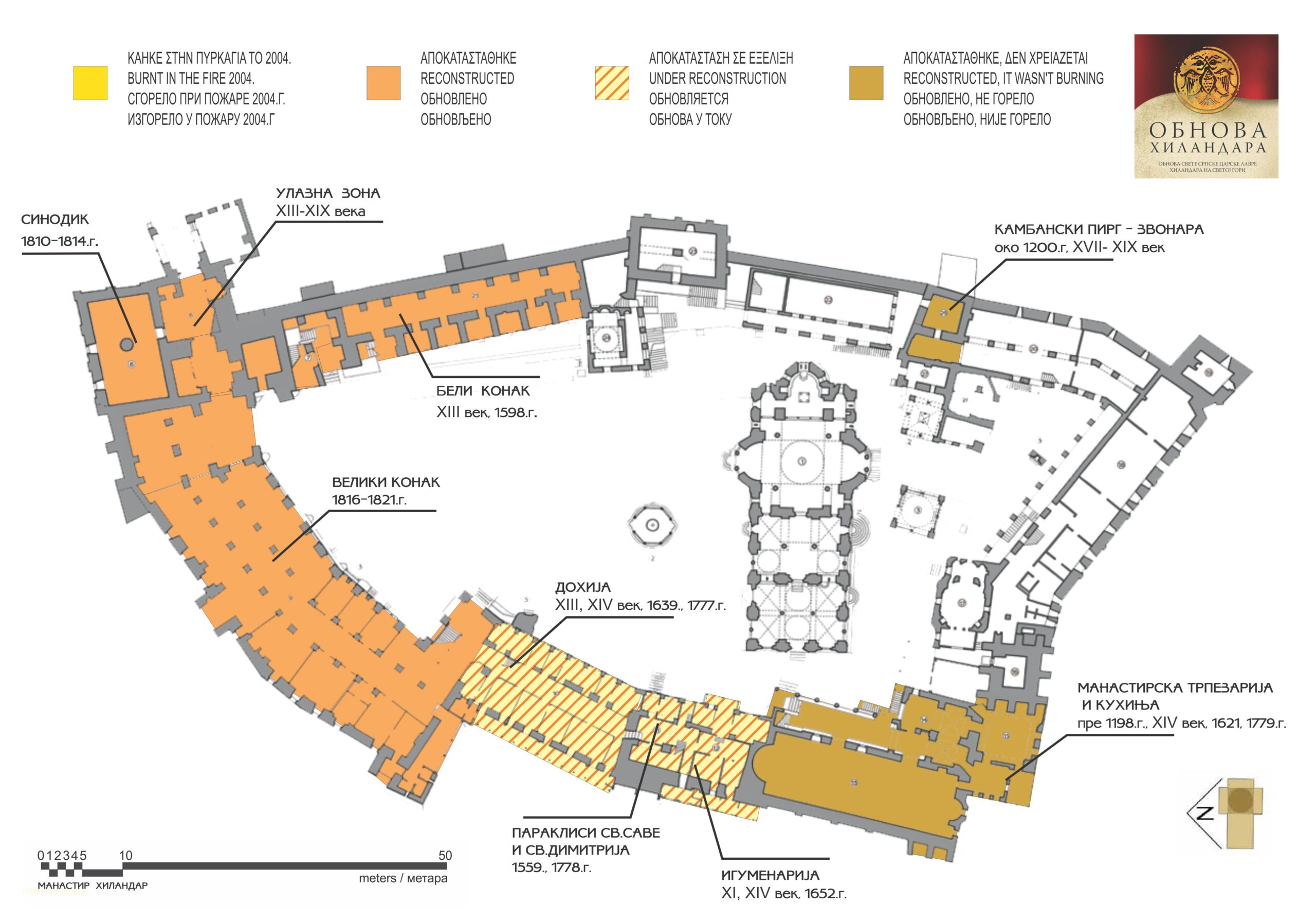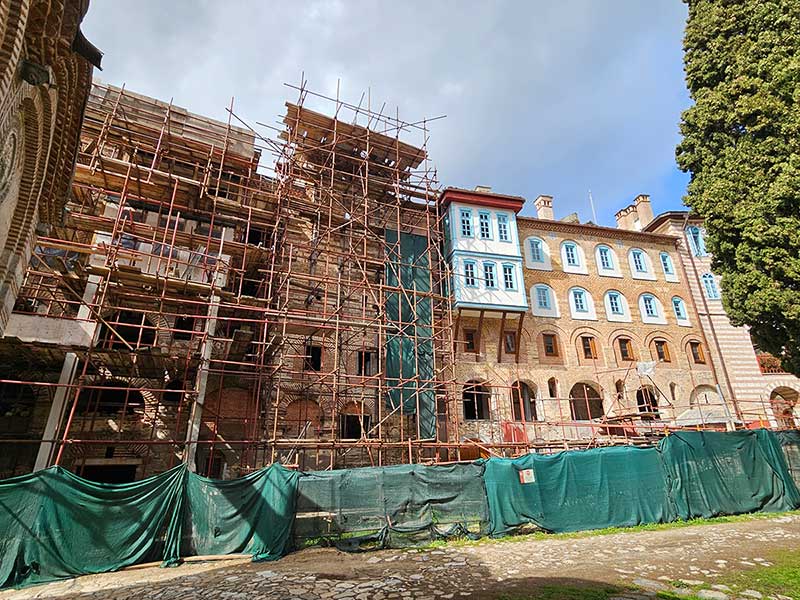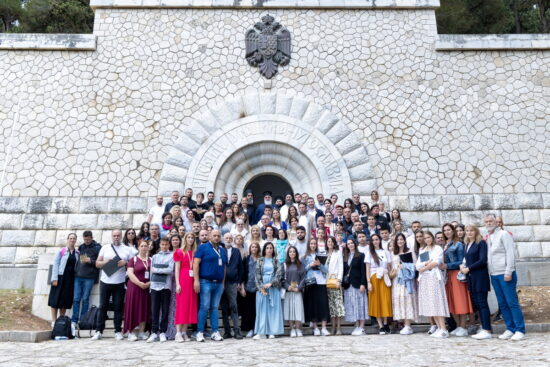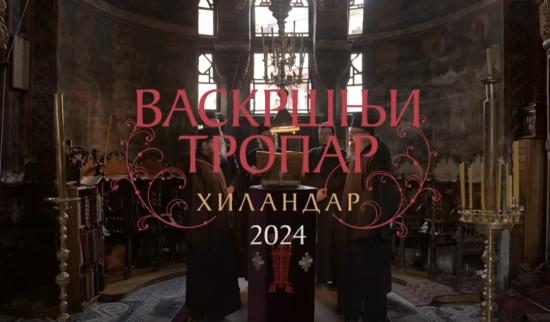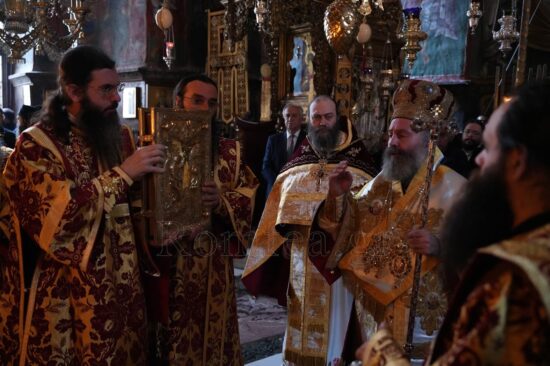Twenty Years Of The Devastating Fire In Hilandar
20 years ago, on this very day, a devastating fire broke out in the Holy Monastery of Hilandar, destroying over a half of the monastery buildings.
It was in only one night, between March 3rd and March 4th, 2004, that the entire northern half of the monastery complex was destroyed and damaged. The fire started from the chimney of the Igumenary’s residence on the south-western side and spread through the cracks created by the settling of the foundation, until it engulfed the roof structure. Then it continued all the way through the attic and the attached buildings until it finally stopped at the open ground between the White residence and the Tower of St. Sava.
The fire caused immeasurable damage to the spiritual and cultural heritage and left innumerable consequences on the basic infrastructure, making it impossible to provide even the most necessary conditions for the life and development of the monastery brotherhood.
So as to avoid endangering the very foundations of the long-term preservation of the monastery, the sustainable model of the restoration of Hilandar implied that, in accordance with its status as a self-governing Holy Mount Lavra, the monastery itself should take over the management of this complex process.
It was with that aim that the Hilandar Restoration Program was adopted, and the existing monastery institution in the homeland, the Endowment of the Holy Monastery of Hilandar, took over the responsibility of the organizational center that gathered and engaged the experts and associates necessary for the implementation of the goal.
As for the contribution of the Government of the Republic of Serbia, in cooperation with the Hilandar monastery, the Commission for Hilandar was formed, and this cooperation with institutions for the protection of the cultural heritage of the Republic of Serbia would continue and develop further.
The Center for the Protection of the Heritage of Svetogorje (KeDAK), an institution of the Republic of Greece, was also involved in the process of the Restoration of Hilandar, within its competences.
The restoration of the burned down monastery residence started in 2006. For eighteen years, in which the patience and determination of the Hilandar brotherhood and the entire team involved in the Restoration can only be characterized as a true miracle of its kind, despite a number of challenges of world economic and social crises, pandemics, and, more often than not, in the circumstances of material insecurity in relation to the scope of the work undertaken, work was carried out that, in terms of the initial requirements and the final results, can only be compared with the reconstruction of the monastery undertaken by the Holy King Milutin in the 14th century.
By March 2024, the complete reconstruction and structural rehabilitation of the Synodikon residence, a three-part complex of the Great Residence with the Chapel of St. Nicholas, had been completed. This unique architectural ensemble constits of the entrance into the monastery with the Old Residence and the White Residence, which suffered the most damage in the fire, and was almost burned down to the foundations. The part of the monastery that was the last to be engulfed by the fire, the one where the work is still in progress, is a complex consisting of four interconnected objects within the western wall, which also serves as the massive western façade for the remaining three walls, including the monastery refectory and the burned quarters of the Igumen and Dohija.
The monumental, stone-built structure of the western wall could not be burned down, understandably, but its static instability in the foundation area compromised the structures of the refectory and the residence, creating conditions for the fire to spread. After several years of research involving not only the contribution of the experts of the restoration team, but also that of the experts from the Faculty of civil engineering from the University of Belgrade and Aristotle University of Thessaloniki, then the Institute Jaroslav Černi and the Institute of Roads from Belgrade, as well as КеДАК-, at the end of year 2023, project solution was agreed upon to be applied in the final stages of the restoration during 2024, with the aim of permanent consolidation of the foundations.
Two years ago, the restoration and reconstruction of the monastery refectory were completed. Although not damaged by the fire, it was to be included in the list of endangered objects due to its general condition and its significant cultural importance, particularly the exceptional wall paintings by Serbian master and Hilandar monk Georgije Mitrofanović.
Current works on the residences of Dohija and Igumen with the chapels of St. Sava and St. Dimitri, started at the end of 2020, represent the restoration of the last structures damaged in the fire.
All rough construction works on the Igumen residence have been completed, and it is in the final stage of artisanal works and furnishing, while in the Igumen residence, static rehabilitation has been completed, and construction work is still
in progress. Special Special attention is paid to the complex works on the chapels of St. Sava and St. Dimitri, which form a unique ensemble within the Igumen residence.
According to the estimates of experts involved in the implementation and conservation-construction supervision, all construction works and installation on the Igumen residence are expected to be completed by the beginning of December 2024.Although some artisanal and installation work, as well as the overall interior design and furnishing of the Igumen residence, will be completed in 2025 and mark the end of the final completion of the restoration from the consequences of the great fire. This estimate has already provoked the impatience and anticipation of the general public to finally see the scaffolding removed from the monastery gate after twenty years. The Hilandar brotherhood hopes to celebrate their monastery Feast, the Presentation of the Holy Virgin, on December 4, 2024, in the surroundings and atmosphere of the previous beauty of the Hilandar Monastery.
The restoration of Hilandar has been, along with the reconstruction of objects damaged in the fire, focusing on the entire heritage of the monastery, the restoration and improvement of its infrastructure, as well as on the provision of the conditions for its maintenance and development in the future. Such an approach to the preservation of cultural, historical, and spiritual heritage represents a form of integral protection of cultural assets, a model that has proven effective in a number of examples worldwide.
This is the year of the continued efforts in the improvement and construction of the monastery infrastructure, including roadways, water supply, sewerage, fire protection, and heating. In 2024, the construction of the hybrid Hilandar energy system, designed to provide solar electrical energy periodically supplemented and supported by automated diesel generators, will be completed and put into functtion. Mount Athos is not connected to the Greek power grid, and ensuring electricity for the monks’ daily life and the preservation of cultural heritage has been a significant challenge for decades. Hilandar has connected the entire space within the scope of a few square kilometers around it to a single power grid, practically covering all the objects where essential functions and maintainance activities take place in the monastery.
Since the great fire and particularly since 2006 onwards, numerous historical parts of the monastery that were not damaged in the fire, but suffered from the effects of time and external influences, have been restored: the complex of old economic objects known as the Senara has been transformed into guest quarters; the tower of St. George with a church on its top has been restored as well; then, the Bell Tower, the roof of the Church of St. Archangel; the monastery arsenal – a harbor where the monastery winery is currently located, the remains of the imperial palace in Hrusija, the Church of the Skete of the Holy Trinity – all of the above mentioned and many other historical parts of the monastery, have been restored.
Throughout the previous years, the activities aimed at protection, restoration, research, and cataloguing the paintings, objects of fine and applied arts, old and rare printed books, archival and library materials, as well as items from the ethnographic collection, have not been interrupted. In the next phase of Hilandar restoration, a particular task will be the improvement of conditions for the preservation, protection, and research of movable heritage. Therefore, a project is currently underway for the reconstruction of the monastery treasury and the construction of a vault – a storage facility where not only the Hilandar treasury, but also the most valuable treasures of the Serbian people will be stored.

